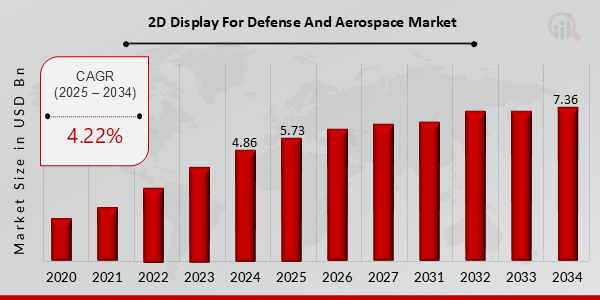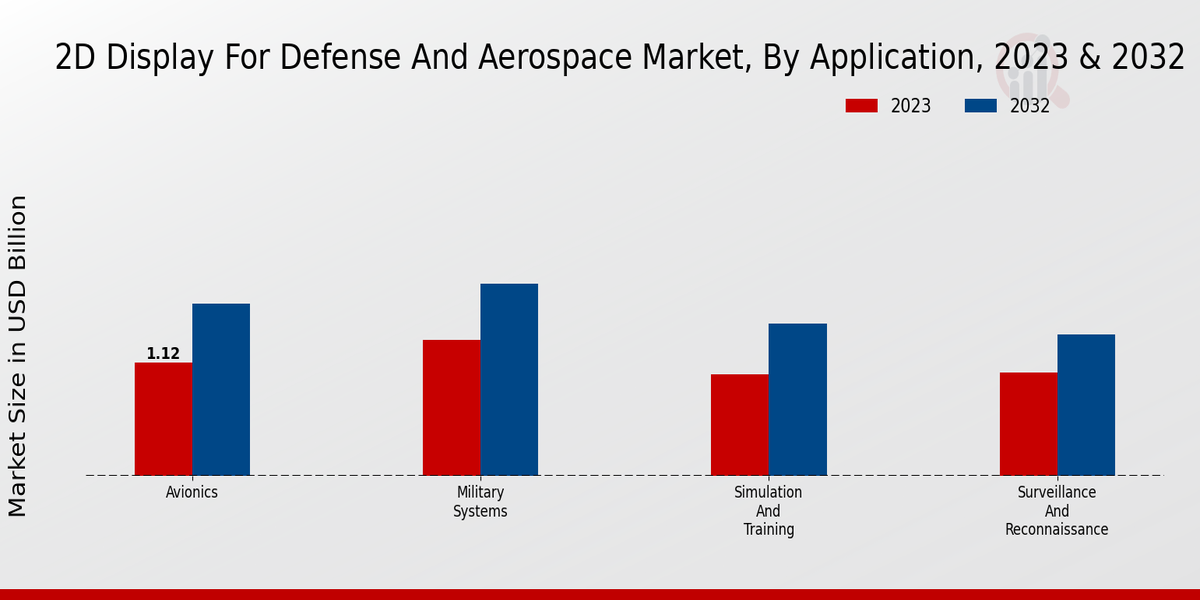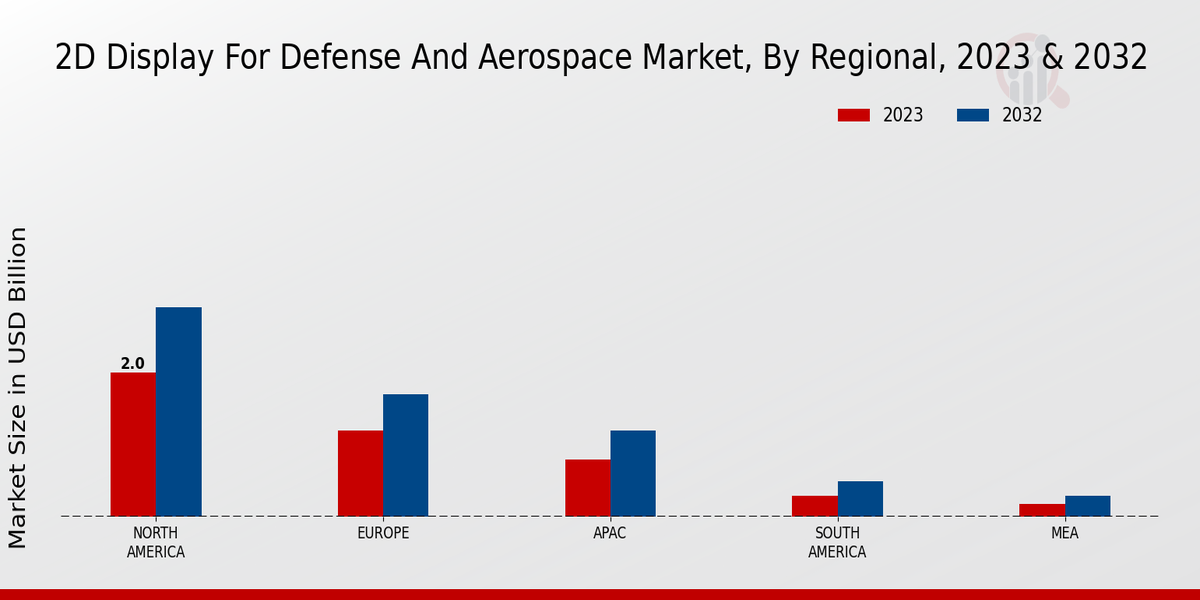Global 2D Display for Defense and Aerospace Market Overview:
2D Display For Defense And Aerospace Market Size was estimated at 4.86 (USD Billion) in 2024. The 2D Display For Defense And Aerospace Market Industry is expected to grow from 5.73 (USD Billion) in 2025 to 7.36 (USD Billion) till 2034, exhibiting a compound annual growth rate (CAGR) of 4.22% during the forecast period (2025 - 2034)
Key 2D Display for Defense and Aerospace Market Trends Highlighted
The 2D Display for Defense and Aerospace Market is experiencing significant growth driven by various factors. Rising defense budgets across nations and the increasing focus on modernizing military technology are key market drivers. Governments are prioritizing the adoption of advanced display systems for applications such as training, surveillance, and cockpit displays, enhancing situational awareness and operational efficiency. Furthermore, the demand for lightweight and high-performance displays is accelerating as manufacturers strive to improve the functionality and usability of defense systems, leading to advancements in display technologies.There are numerous opportunities waiting to be explored within this market.
The integration of augmented reality (AR) and virtual reality (VR) into training simulations presents a notable opportunity to enhance the capabilities of display systems in defense and aerospace. Additionally, emerging markets are becoming more interested in upgrading their defense capabilities, thus creating avenues for manufacturers to expand their reach. Collaborations and partnerships with tech companies specializing in display innovations can also help capture new opportunities for growth, tapping into the evolving requirements of military applications. Recent trends showcase a move towards digitalization in the defense sector, with increased investments in smart technologies. Interactive displays are gaining traction, as they offer improved user interfaces and operational flexibility.
The trend towards integrating 2D displays with other advanced technologies, like sensor fusion and real-time data analytics, also continues to rise, presenting comprehensive solutions for complex military operations. Sustainability is becoming a more prominent theme, with companies seeking eco-friendly materials and energy-efficient technologies to appeal to growing environmental concerns. This blending of technology and sustainability reflects a shift in focus, aiming to meet both operational requirements and ethical considerations in defense and aerospace applications.

Source: Primary Research, Secondary Research, MRFR Database and Analyst Review
2D Display for Defense and Aerospace Market Drivers
Increasing Investment in Defense and Aerospace Technologies
One of the most significant drivers for the 2D Display for Defense and Aerospace Market Industry is the increasing investment in modernizing defense and aerospace technologies. Countries across the globe are increasing their defense budgets and committing substantial resources to advance their military capabilities. This investment is being directed towards upgrading existing platforms and developing new systems, which require state-of-the-art display technologies. Enhanced 2D displays are critical for improving the situational awareness of military personnel and pilots, enabling them to make informed decisions quickly in high-stakes environments. Moreover, the trend of integrating advanced technologies such as augmented reality (AR) and virtual reality (VR) into military applications necessitates the use of high-performance 2D display systems.
These displays are essential for training simulations, reconnaissance missions, and battlefield management systems, where accurate and real-time data visualization is integral. As the emphasis on technological advancements in the defense sector continues to grow, the demand for sophisticated 2D displays is expected to increase correspondingly. The ongoing development of defense and aerospace applications places considerable pressure on manufacturers to innovate and develop 2D display solutions that meet the rigorous requirements of military environments, thereby propelling the growth of the 2D Display for Defense and Aerospace Market Industry.
Technological Advancements in Display Solutions
The evolution of display technologies is a crucial driver of growth in the 2D Display for Defense and Aerospace Market Industry. Continuous advancements in display resolution, brightness, and energy efficiency significantly enhance the performance of 2D displays used in defense and aerospace applications. Innovative technologies, such as organic light-emitting diodes (OLEDs) and liquid crystal displays (LCDs), offer improved image quality and longer service life, which are essential for mission-critical operations. The capability of these advanced displays to function effectively under various environmental conditions ensures their relevance and broad implementation across different military and aerospace platforms. As technological advancements continue, the market is likely to witness a surge in the adoption of these display solutions, as stakeholders seek to capitalize on their benefits.
Growing Demand for Enhanced Situational Awareness
Enhanced situational awareness is crucial in defense and aerospace operations, driving the need for high-quality 2D displays. The ability to visualize complex data clearly and quickly can significantly impact operational effectiveness, making this demand a primary growth driver. As military operations become increasingly data-driven, the necessity for 2D displays that can present information concisely is paramount in the 2D Display for Defense and Aerospace Market Industry.
2D Display for Defense and Aerospace Market Segment Insights:
2D Display for Defense and Aerospace Market Application Insights
The 2D Display for Defense and Aerospace Market, valued at 4.48 USD Billion in 2023, is witnessing a steady growth trajectory driven by a rising demand for advanced displays in various applications, crucial for mission success. Among these applications, Avionics stands out with a value of 1.12 USD Billion in 2023 and is projected to increase to 1.7 USD Billion by 2032, highlighting its importance in aircraft navigation and operational control systems. This segment caters to the need for enhanced visibility and communication in cockpit environments, thus dominating the market. Military Systems, valued at 1.34 USD Billion in 2023, dominates as it incorporates 2D display technology for various defense operations, facilitating real-time data visualization and improving situational awareness, eventually expected to grow to 1.9 USD Billion by 2032, representing a vital area of focus in defense capabilities.
Furthermore, the Simulation and Training application, valued at 1.0 USD Billion in 2023, plays a critical role in preparing personnel for diverse operations through realistic training environments, which is essential for operational readiness and efficiency. This segment too is anticipated to experience growth, reaching 1.5 USD Billion by 2032. Lastly, the Surveillance and Reconnaissance area, valued at 1.02 USD Billion in 2023, emphasizes the growing need for sophisticated visual systems in intelligence operations, contributing to greater accuracy and effectiveness in threat detection and analysis, with an expected increase to 1.4 USD Billion by 2032.
The segmentation of the 2D Display for Defense and Aerospace Market reflects a landscape rich with opportunities, driven by the ongoing advancements in technology, providing a clear path for growth while also facing challenges such as budget constraints and integration complexities within existing systems. The insights provided signify the market's dynamics, emphasizing not just the revenue potential but also the increased reliance on technology to meet operational demands in defense and aerospace sectors. The combination of these driving factors reinforces the significance of each application area, shaping the future development of the 2D Display for Defense and Aerospace Market industry.

Source: Primary Research, Secondary Research, MRFR Database and Analyst Review
2D Display for Defense and Aerospace Market Technology Insights
The 2D Display for Defense and Aerospace Market is experiencing notable growth, with a market value expected to reach 4.48 billion USD in 2023. This growth is driven by advancements in technology and increasing demand for high-performance displays in defense and aerospace applications. The segmentation of the market by technology includes various display types like Liquid Crystal Display (LCD), Organic Light Emitting Diode (OLED), Light Emitting Diode (LED), and Plasma Display. LCD technology remains significant for its cost-effectiveness and energy efficiency, widely used in military displays and cockpit instruments.
OLED is gaining traction due to its superior contrast and flexibility, making it ideal for modern high-resolution applications. LED displays dominate in rugged environments for their durability and brightness, while Plasma Display is noted for its excellent color reproduction. As the industry evolves, these technologies respond to the ongoing trends of miniaturization, integration, and the need for enhanced visual capabilities, reflecting critical advancements in the 2D Display for Defense and Aerospace Market data. These technological innovations contribute to overall market growth and redefine the capabilities in defense and aerospace sectors.
2D Display for Defense and Aerospace Market End Use Insights
The 2D Display for Defense and Aerospace Market is poised for significant growth, with a market valuation of 4.48 billion USD in 2023. As the industry progresses, the importance of End Use segments like Airborne Systems, Land Systems, and Naval Systems becomes increasingly clear. Airborne Systems hold a pivotal role, given the rising demand for advanced avionics and mission-critical display technologies in military and commercial aviation. Land Systems are equally essential, as they enhance situational awareness and operational efficiency in ground vehicles.
Naval Systems are important contributors as well, supporting the need for reliable and robust display technologies in maritime operations. The 2D Display for Defense and Aerospace Market data indicates that these segments not only dominate market growth but also drive innovations that meet the rigorous demands of defense and aerospace applications. The market trends are influenced by advancements in technology, increasing defense spending, and the growing emphasis on modernizing armed forces across the globe. However, challenges such as high development costs and strict regulatory requirements may affect market expansion. Despite this, opportunities abound for vendors who can innovate and adapt to emerging technologies in these critical sectors.
2D Display for Defense and Aerospace Market Display Size Insights
The 2D Display for Defense and Aerospace Market focuses significantly on the Display Size segment, which is integral to enhancing operational capabilities. As of 2023, the overall market is valued at 4.48 billion USD, showcasing the importance of effective display systems in defense and aerospace applications. Within this segment, displays are categorized into Small, Medium, and Large sizes, catering to diverse requirements in various platforms such as aircraft, ground vehicles, and naval systems. Small Displays are crucial for compact systems that require less power and space, often employed in handheld devices and avionics. In contrast, Medium Displays strike a balance between visibility and function, often utilized in cockpit instrumentation and command centers.
Large Displays dominate in control rooms and simulation training, offering extensive visual data presentation for enhanced situational awareness. Growth in this market can be attributed to continued advancements in display technology, rising defense budgets, and increasing adoption of advanced avionics systems, along with the necessity for improved user interfaces in complex environments. Challenges persist in the form of compatibility issues and the high costs involved in upgrading existing systems. Nevertheless, the increasing convergence of technology presents opportunities for innovation within this segment. The statistics underline the importance of Display Size in achieving operational excellence in the 2D Display for Defense and Aerospace Market.
2D Display for Defense and Aerospace Market Regional Insights
The 2D Display for Defense and Aerospace Market revenue in 2023 reached 4.48 USD Billion, with notable contributions from different regions showing varied dynamics. North America holds a majority share, valued at 2.0 USD Billion, and is projected to grow significantly to 2.9 USD Billion by 2032, driven by advanced technologies in defense applications and a robust aerospace industry. Europe follows with a significant valuation of 1.2 USD Billion in 2023, expected to rise to 1.7 USD Billion, reflecting strong investments in military modernization and regional security initiatives.
The APAC region, valued at 0.8 USD Billion in 2023, is likely to experience growth to 1.2 USD Billion, as nations enhance their defense capabilities, presenting substantial opportunities for market players. South America, with a valuation of 0.3 USD Billion, is anticipated to increase to 0.5 USD Billion, while the MEA region, starting at 0.18 USD Billion and reaching 0.3 USD Billion, showcases growing interest in defense procurement and technological upgrades. These trends highlight the diverse opportunities across regions within the 2D Display for Defense and Aerospace Market, contributing to its overall growth trajectory.

Source: Primary Research, Secondary Research, MRFR Database and Analyst Review
2D Display for Defense and Aerospace Market Key Players and Competitive Insights:
The 2D Display for Defense and Aerospace Market is characterized by a competitive landscape that reflects the ongoing advancements in technology and the increasing need for sophisticated display solutions. This sector encompasses a wide range of applications, including military operations, aircraft displays, and various defense systems, necessitating high-performance visual solutions that enhance situational awareness and operational efficiency. The continuous evolution of display technologies, combined with the rising investments in defense capabilities by governments worldwide, is driving the demand for innovative and reliable 2D display systems. Competitors in this market are striving to differentiate their offerings through superior image quality, rugged designs, and integration capabilities with various defense and aerospace platforms, creating a nuanced environment for market players.
Rockwell Collins stands out in the 2D Display for Defense and Aerospace Market with its extensive experience in providing advanced display solutions tailored for military and aerospace applications. The company has established a robust market presence, leveraging its expertise in avionics and communication systems to deliver high-quality 2D displays that meet the rigorous requirements of defense operations. Rockwell Collins is recognized for its commitment to innovation, demonstrated by its continuous investment in research and development, resulting in state-of-the-art technologies that enhance the functionality and reliability of display solutions. The integration of user-friendly interfaces and advanced visualization capabilities has positioned Rockwell Collins favorably in the market, allowing it to cater effectively to the evolving demands of customers within the defense and aerospace sectors.
Hewlett Packard Enterprise has made significant strides in the 2D Display for Defense and Aerospace Market through its focus on delivering robust and versatile display solutions that integrate seamlessly with various defense systems. The company is known for its strong emphasis on security and data integrity, which is crucial in defense operations, making its offerings highly desirable in this competitive landscape. Hewlett Packard Enterprise combines innovative technology with high performance to provide displays that not only fulfill operational needs but also enhance overall system effectiveness. The company’s dedication to sustainability and energy-efficient products is also gaining traction, aligning with the growing preference for environmentally conscious solutions among defense contractors. This strategic approach has reinforced Hewlett Packard Enterprise's position in the market, allowing it to respond adeptly to the complexities and requirements of modern military and aerospace applications.
Key Companies in the 2D Display for Defense and Aerospace Market Include:
2D Display for Defense and Aerospace Industry Developments
In the 2D Display for Defense and Aerospace Market, recent developments reveal a surge in technological advancements and increasing demand for high-resolution displays. Companies such as Rockwell Collins and Honeywell are enhancing their product lines with next-generation displays, focusing on improved durability and performance in challenging environments. Hewlett Packard Enterprise and L3Harris Technologies are investing significantly in R&D to incorporate augmented reality features into their display systems, aiming to provide operators with enhanced situational awareness. Additionally, General Dynamics and BAE Systems have been involved in collaborative projects to advance display technology for military applications, reflecting a trend towards interoperability among defense contractors.
In terms of mergers and acquisitions, Meggitt successfully acquired a relevant division within the aerospace display sector, bolstering its capabilities and market position. This consolidation trend is evident as companies like Thales and Raytheon Technologies look to expand their portfolio to include cutting-edge display solutions tailored for the defense sector. The overall market growth is fueled by increasing defense budgets globally, which emphasizes the importance of advanced display technologies in modern warfare and aerospace operations.
2D Display for Defense and Aerospace Market Segmentation Insights
-
2D Display for Defense and Aerospace Market Application Outlook
-
2D Display for Defense and Aerospace Market Technology Outlook
-
2D Display for Defense and Aerospace Market End Use Outlook
-
2D Display for Defense and Aerospace Market Display Size Outlook
-
2D Display for Defense and Aerospace Market Regional Outlook
|
Report Attribute/Metric
|
Details
|
|
Market Size 2024
|
USD 4.86 Billion
|
|
Market Size 2025
|
USD 5.73 Billion
|
|
Market Size 2034
|
USD 7.36 Billion
|
|
Compound Annual Growth Rate (CAGR)
|
4.22% (2025-2034)
|
|
Base Year
|
2024
|
|
Market Forecast Period
|
2025-2034
|
|
Historical Data
|
2020-2023
|
| Market Forecast Units |
USD Billion |
|
Report Coverage
|
Revenue Forecast, Competitive Landscape, Growth Factors, and Trends
|
| Key Companies Profiled |
Rockwell Collins, Hewlett Packard Enterprise, General Dynamics, CurtissWright, Meggitt, L3Harris Technologies, Honeywell, Leonardo, BAE Systems, Panasonic, Saab, Raytheon Technologies, Thales, Elbit Systems, Northrop Grumman |
| Segments Covered |
Application, Technology, End Use, Display Size, Regional |
| Key Market Opportunities |
Advanced simulation technology integration, Military-grade rugged displays demand, Increasing UAV applications, Augmented reality enhancements, Enhanced training and mission scenarios |
| Key Market Dynamics |
Technological advancements in displays, Increased defense budgets, Growing demand for situational awareness, Need for lightweight materials, Rising military modernization efforts |
| Countries Covered |
North America, Europe, APAC, South America, MEA |
Frequently Asked Questions (FAQ) :
The market is expected to be valued at 7.36 USD billion in 2034.
The expected CAGR for the market during this period is 4.22%.
North America is projected to hold the largest market share, valued at 2.9 USD billion in 2032.
The market value for Military Systems is expected to reach 1.9 USD billion in 2032.
Key players include Rockwell Collins, General Dynamics, L3Harris Technologies, and Raytheon Technologies.
The market size for Simulation and Training is valued at 1.0 USD billion in 2023.
The expected market size for the APAC region is 1.2 USD billion in 2032.
The market value for Surveillance and Reconnaissance application is 1.02 USD billion in 2023.
The South America market is expected to be valued at 0.5 USD billion in 2032.
The market value for Avionics is projected to reach 1.7 USD billion in 2032.

















